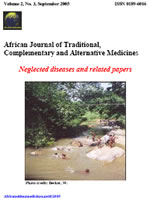
|
African Journal of Traditional, Complementary and Alternative Medicines
African Ethnomedicines Network
ISSN: 0189-6016
Vol. 13, No. 2, 2016, pp. 185-190
|
 Bioline Code: tc16045
Bioline Code: tc16045
Full paper language: English
Document type: Research Article
Document available free of charge
|
|
|
African Journal of Traditional, Complementary and Alternative Medicines, Vol. 13, No. 2, 2016, pp. 185-190
| en |
A CYTOGENIC MONITORING APPROACH OF HOSPITAL WORKERS OCCUPTIONALLY EXPOSED TO IONIZING RADIATIONS USING MICRONUCLEUS ASSAY
Sultana, Salma; Tabassum, Sadia; Sultana, Tayyaba; Al-Ghanim, K. A.; Shah, Komal; Shahid, Tehniat & Mahboob, Shahid
Abstract
Backgroud: The objective of this study was to determine chromosomal damage in occupational workers of the radiation department
from three different hospitals, Faisalabad, Pakistan exposed for a long term to ionizing radiations using micronucles (MN) assay. A
comparison between exposed and non-exposed subjects (controlled) of same age exhibited a significant an increase in the number of
micronuclei in occupational workers. MN frequency increases with an increase in age and duration of exposure in both sexes but higher
in females.
Materials and Methods: The study was conducted at the District Head Quarter Hospital (DHQ), Punjab Institute of Nuclear Medicine
(PINUM) and Allied Hospital, Faisalabad, Pakistan. The total 145 subjects were selected from these hospitals. The subjects were divided
into two groups. The control group (N= 40) (20 males and 20 females) of healthy subjects (no exposure) and the second group of subjects
(N=105) (68 males and 37 females) subjects of occupational workers who were indirectly exposed to radiation. Blood samples (2ml)
were collected in sodium heparinised vaccutainer tubes through venipuncture from both the groups. Disposable syringes were used for
this purpose. For the evaluation of MN yield, slides were prepared by following the method of Jorge et al. (2004).
Results: A significant difference in micro nuclear induction was observed between the occupational subjects and the control subjects and
as well as in females and in males (P < 0.01). Females are more vulnerable to ionizing radiation than males. In females, MN yield was
two times higher than males. MN frequency was increased with an increase in age and duration of exposure in both sexes, but higher in
females and may be due to an increase in chromosomal loss in hospital workers. There is an individual response to the physical noxa,
depending on sex, age and exposure. Smoking and drinking habits do not have a significant effect in increasing the number of MN in
occupationally exposed workers.
Conclusion: It was concluded that females are more vulnerable to ionizing radiations than males. MN test can be used as a biomarker
with a predictive value for the estimation in occupationally exposed subjects.
Keywords
Radiations; Hospital workers; Sex; Micronucleus assay; Chromosomal damage
|
| |
© Copyright 2016 - African Journal of Traditional, Complementary and Alternative Medicines
Alternative site location: http://journals.sfu.ca/africanem/index.php/ajtcam
|
|
